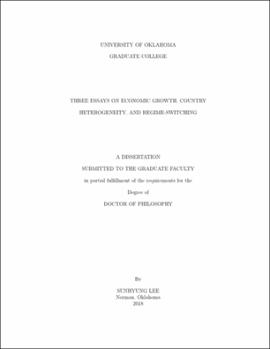| dc.contributor.advisor | Rogers, Cynthia | |
| dc.contributor.advisor | Demir, Firat | |
| dc.contributor.author | Lee, Sunhyung | |
| dc.date.accessioned | 2018-05-11T15:31:28Z | |
| dc.date.available | 2018-05-11T15:31:28Z | |
| dc.date.issued | 2018-05-11 | |
| dc.identifier.uri | https://hdl.handle.net/11244/299888 | |
| dc.description.abstract | In the first chapter, we offer a new way of examining the relationship between bilateral FDI flows and economic growth in the long-run using a unique dataset. Moreover, we provide a three-regime analysis under the North-Emerging South-South framework to highlight heterogeneity in parameters based on income levels. The framework also allows us to show an evidence of a positive association between bilateral FDI flows and business cycle synchronization especially for the North \& North and Emerging \& Emerging country pairs. Our comprehensive analysis addresses issues regarding sample selection, endogeneity, cross-sectional dependency, and co-integration.
In the second chapter, we show that the efficacy of fiscal decentralization in enhancing economic growth or labor productivity growth depends on whether taxes are collected at the central level or at the sub-national level. To empirically examine the differential effects, we introduce a distinct measure of fiscal decentralization that serves as a proxy for taxes collected at the sub-national level. In addition to proposing a new measure, our analysis examines the long-run association between fiscal decentralization and economic or labor productivity growth; considers heterogeneity in parameters by federalism status and income levels; identifies sources of growth; and incorporates nonlinearity to show that neither a complete revenue decentralization nor centralization is optimal.
In the third chapter, we provide a novel approach of estimating a regime-switching nonlinear and non-Gaussian state space model based on a particle learning scheme. In particular, we extend the particle learning method in Liu and West (2001) by constructing a new proposal distribution for the latent regime index variable that incorporates all available information contained in the current and past observations. The Monte Carlo simulation result implies that our approach categorically outperforms a popular existing algorithm. To demonstrate the model, the proposed algorithm is used to analyze the underlying dynamics of U.S. excess stock return. | en_US |
| dc.language | en_US | en_US |
| dc.subject | Economic growth, Country heterogeneity, Regime-switching | en_US |
| dc.title | THREE ESSAYS ON ECONOMIC GROWTH, COUNTRY HETEROGENEITY, AND REGIME-SWITCHING | en_US |
| dc.contributor.committeeMember | Burge, Gregory | |
| dc.contributor.committeeMember | Kim, Jaeho | |
| dc.contributor.committeeMember | Barry, Colin | |
| dc.date.manuscript | 2018-05-11 | |
| dc.thesis.degree | Ph.D. | en_US |
| ou.group | College of Arts and Sciences::Department of Economics | en_US |
